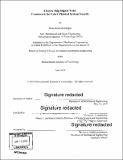Electric ship digital twin : framework for cyber-physical system security
Author(s)
Gilligan, Brian Kenneth.
Download1117714720-MIT.pdf (9.452Mb)
Other Contributors
Massachusetts Institute of Technology. Department of Mechanical Engineering.
Advisor
Michael S. Triantafyllou.
Terms of use
Metadata
Show full item recordAbstract
This thesis presents a dynamic model that can be used for a digital twin of an electric ship. The model is an end-to-end simulation of a ship from prime mover to maneuvering, seakeeping, and propeller ventilation in random waves representing the behavior of a physical ship. There is a trend towards increasingly networked sensors and actuators to enable condition monitoring, ensure efficient operation, and allow for autonomy. However, a cyberattack on a networked control system presents not just the possibility of information theft but of physical system damage and loss of control. Thus, a detection scheme is proposed for cyber-physical systems using a joint unscented Kalman filter. It is employed to detect cyberattacks in the simulation model of an electric ship including sensor attacks and controller attacks on a gas turbine, synchronous generator, and automatic heading control. Finally, a system theoretic framework is presented for optimal sensor placement to minimize cyber vulnerability.
Description
Thesis: S.M. in Naval Architecture and Marine Engineering, Massachusetts Institute of Technology, Department of Mechanical Engineering, 2019 Cataloged from PDF version of thesis. Includes bibliographical references (pages 90-95).
Date issued
2019Department
Massachusetts Institute of Technology. Department of Mechanical EngineeringPublisher
Massachusetts Institute of Technology
Keywords
Mechanical Engineering.